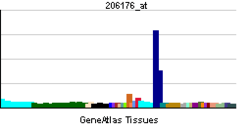Bone morphogenetic protein 6
| View/Edit Human | View/Edit Mouse |
Bone morphogenetic protein 6 is a protein that in humans is encoded by the BMP6 gene.[4][5][6]
The protein encoded by this gene is a member of the TGFβ superfamily. Bone morphogenetic proteins are known for their ability to induce the growth of bone and cartilage. BMP6 is able to induce all osteogenic markers in mesenchymal stem cells.
The bone morphogenetic proteins (BMPs) are a family of secreted signaling molecules that can induce ectopic bone growth. BMPs are part of the transforming growth factor-beta (TGFB) superfamily. BMPs were originally identified by an ability of demineralized bone extract to induce endochondral osteogenesis in vivo in an extraskeletal site. Based on its expression early in embryogenesis, the BMP encoded by this gene has a proposed role in early development. In addition, the fact that this BMP is closely related to BMP5 and BMP7 has led to speculation of possible bone inductive activity. As of April 2009, an additional function of BMP6 has been identified as described in Nature Genetics April; 41 [4]:386-8. BMP6 is the key regulator of hepcidin, the small peptide secreted by the liver which is the major regulator of iron metabolism in mammals.
References
- ↑ "Diseases that are genetically associated with BMP6 view/edit references on wikidata".
- ↑ "Human PubMed Reference:".
- ↑ "Mouse PubMed Reference:".
- ↑ Hahn GV, Cohen RB, Wozney JM, Levitz CL, Shore EM, Zasloff MA, Kaplan FS (Dec 1992). "A bone morphogenetic protein subfamily: chromosomal localization of human genes for BMP5, BMP6, and BMP7". Genomics. 14 (3): 759–62. doi:10.1016/S0888-7543(05)80181-8. PMID 1427904.
- ↑ Sauermann U, Meyermann R, Schluesener HJ (Jan 1993). "Cloning of a novel TGF-beta related cytokine, the vgr, from rat brain: cloning of and comparison to homologous human cytokines". J Neurosci Res. 33 (1): 142–7. doi:10.1002/jnr.490330118. PMID 1453478.
- 1 2 "Entrez Gene: BMP6 bone morphogenetic protein 6".
Further reading
- Celeste AJ, Iannazzi JA, Taylor RC, et al. (1991). "Identification of transforming growth factor beta family members present in bone-inductive protein purified from bovine bone". Proc. Natl. Acad. Sci. U.S.A. 87 (24): 9843–7. doi:10.1073/pnas.87.24.9843. PMC 55270
 . PMID 2263636.
. PMID 2263636. - Schluesener HJ, Meyermann R (1995). "Immunolocalization of BMP-6, a novel TGF-beta-related cytokine, in normal and atherosclerotic smooth muscle cells". Atherosclerosis. 113 (2): 153–6. doi:10.1016/0021-9150(94)05438-O. PMID 7605353.
- Gitelman SE, Kobrin MS, Ye JQ, et al. (1994). "Recombinant Vgr-1/BMP-6-expressing tumors induce fibrosis and endochondral bone formation in vivo". J. Cell Biol. 126 (6): 1595–609. doi:10.1083/jcb.126.6.1595. PMC 2290953
 . PMID 8089189.
. PMID 8089189. - Barnes J, Anthony CT, Wall N, Steiner MS (1997). "Bone morphogenetic protein-6 expression in normal and malignant prostate". World Journal of Urology. 13 (6): 337–43. PMID 9116752.
- Hamdy FC, Autzen P, Robinson MC, et al. (1997). "Immunolocalization and messenger RNA expression of bone morphogenetic protein-6 in human benign and malignant prostatic tissue". Cancer Res. 57 (19): 4427–31. PMID 9331107.
- Olavesen MG, Bentley E, Mason RV, et al. (1998). "Fine mapping of 39 ESTs on human chromosome 6p23-p25". Genomics. 46 (2): 303–6. doi:10.1006/geno.1997.5032. PMID 9417921.
- Rickard DJ, Hofbauer LC, Bonde SK, et al. (1998). "Bone morphogenetic protein-6 production in human osteoblastic cell lines. Selective regulation by estrogen". J. Clin. Invest. 101 (2): 413–22. doi:10.1172/JCI119880. PMC 508581
 . PMID 9435314.
. PMID 9435314. - Tamada H, Kitazawa R, Gohji K, et al. (1998). "Molecular cloning and analysis of the 5'-flanking region of the human bone morphogenetic protein-6 (BMP-6)". Biochim. Biophys. Acta. 1395 (3): 247–51. doi:10.1016/S0167-4781(97)00191-7. PMID 9512655.
- Ebisawa T, Tada K, Kitajima I, et al. (2000). "Characterization of bone morphogenetic protein-6 signaling pathways in osteoblast differentiation". J. Cell. Sci. 112 (20): 3519–27. PMID 10504300.
- Heikinheimo KA, Laine MA, Ritvos OV, et al. (1999). "Bone morphogenetic protein-6 is a marker of serous acinar cell differentiation in normal and neoplastic human salivary gland". Cancer Res. 59 (22): 5815–21. PMID 10582704.
- Ahmed N, Sammons J, Carson RJ, et al. (2001). "Effect of bone morphogenetic protein-6 on haemopoietic stem cells and cytokine production in normal human bone marrow stroma". Cell Biol. Int. 25 (5): 429–35. doi:10.1006/cbir.2000.0662. PMID 11401330.
- Shimizu M, Higuchi K, Kasai S, et al. (2003). "A congenic mouse and candidate gene at the Chromosome 13 locus regulating bone density". Mamm. Genome. 13 (7): 335–40. doi:10.1007/s00335-001-2129-4. PMID 12140680.
- Strausberg RL, Feingold EA, Grouse LH, et al. (2003). "Generation and initial analysis of more than 15,000 full-length human and mouse cDNA sequences". Proc. Natl. Acad. Sci. U.S.A. 99 (26): 16899–903. doi:10.1073/pnas.242603899. PMC 139241
 . PMID 12477932.
. PMID 12477932. - Moser M, Binder O, Wu Y, et al. (2003). "BMPER, a novel endothelial cell precursor-derived protein, antagonizes bone morphogenetic protein signaling and endothelial cell differentiation". Mol. Cell. Biol. 23 (16): 5664–79. doi:10.1128/MCB.23.16.5664-5679.2003. PMC 166349
 . PMID 12897139.
. PMID 12897139. - Bobacz K, Gruber R, Soleiman A, et al. (2003). "Expression of bone morphogenetic protein 6 in healthy and osteoarthritic human articular chondrocytes and stimulation of matrix synthesis in vitro". Arthritis Rheum. 48 (9): 2501–8. doi:10.1002/art.11248. PMID 13130469.
- Lories RJ, Derese I, Ceuppens JL, Luyten FP (2003). "Bone morphogenetic proteins 2 and 6, expressed in arthritic synovium, are regulated by proinflammatory cytokines and differentially modulate fibroblast-like synoviocyte apoptosis". Arthritis Rheum. 48 (10): 2807–18. doi:10.1002/art.11389. PMID 14558086.
- Mungall AJ, Palmer SA, Sims SK, et al. (2003). "The DNA sequence and analysis of human chromosome 6". Nature. 425 (6960): 805–11. doi:10.1038/nature02055. PMID 14574404.
- Laurikkala J, Kassai Y, Pakkasjärvi L, et al. (2004). "Identification of a secreted BMP antagonist, ectodin, integrating BMP, FGF, and SHH signals from the tooth enamel knot". Dev. Biol. 264 (1): 91–105. doi:10.1016/j.ydbio.2003.08.011. PMID 14623234.
This article incorporates text from the United States National Library of Medicine, which is in the public domain.

